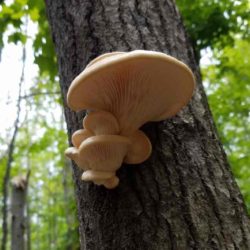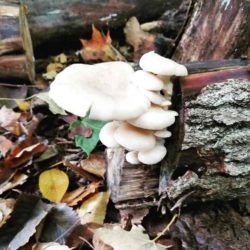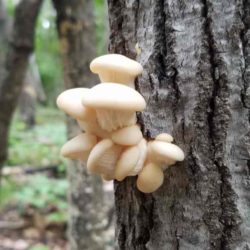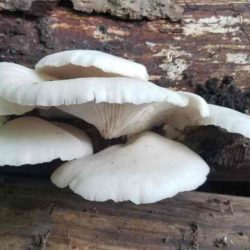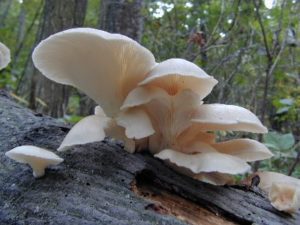
Oyster
Pleurotus Ostreatus
AKA: Pearls
Description:
Grows on DEAD wood, either singular or in clusters with overlapping caps. Generally whitish caps and gills, but can be light gray or brownish. White gills from edge of cap all the way to base of stem. Gills run in parallel either straight or wavy. Stem obliquely attaches cap to wood and is off-centered to one side. Pink or lilac/gray spore print.
Can often be found year-round (dependent on climate).
Coolness Factor:
Due to incredible absorption capabilities, oysters can be used to help clean up pollutants in the environment. Increasing development for potential use in cleaning up oil spills!
Potential cardiovascular and cholesterol-reducing benefits, antibacterial and anti-inflammatory.
Oyster mycelia has actually been shown to be somewhat carnivorous! They consume and process very small nematodes, which provide nutrients to the mushroom.
Where Found:
Oysters are not nearly as picky to specific tree species as many other mushrooms are.
Most common: poplar/aspen, cottonwood, elm and maple but are not exclusive to these. Will not find on conifers.
ALWAYS grows on DEAD wood, whether stump, tree or log.
Also super easy to cultivate if you are into that.
Tips:
Look high and low and on all sides of a log or tree.
Inspect carefully for bugs! Beat the bugs and you have a delicious mushroom on your hands! Look for pinholes in the stem or “mealy” runs in the cap.
Cleaning
Sometimes oysters are clean as a whistle and sometimes they are hardly worth the trouble. The gills can be deep at times so getting a brush and a bit of water in between them can flush out the dirt and hidden bugs. For the most part, you will be dealing with some tiny beetle looking things which are super easy to just brush or blow off. However, once you cut it (preferably along the gills), look for little white worms, maybe a cm or two long. They can hide fairly well since oysters are generally white, but have little black heads. They are technically no big deal and can be eaten without harm, but the concept shakes most folks. Personal preference towards clean, not very buggy ones but up to the harvester and consumer! Some like a little extra protein.
Cooking
Oysters are pretty versatile compared to some other wild mushrooms. They typically do very well sauteed, fried and broiled. Pair extremely well with most fish and seafood, which is no particular surprise considering their name! Saute in oil and/or butter until slightly browned, or can carmelize more which is pretty tasty!
Preserving
Oysters are one of the easiest and best to dehydrate. They hold most of their taste and consistency upon rehydrating and cooking. Dried oysters can often be stored in an air tight glass jar/container for months, if not years! Make sure they are fully dehydrated before putting lid on jar otherwise you will not have oysters for years, but rather moldly oysters for weeks (personal experience maybe?). They can also be frozen raw or cooked, but do lose more flavor and texture. Dehydrating is typically the way to go.
Look Alikes:
Elm Oyster (Hypsizygus ulmarius) – stem attaches to MIDDLE of cap, not obliquely to the side. Still considered edible, but not delicious compared to normal oysters.
Angel Wings (Pleurocybella porrigens) – considered edible, but not always recommended* Adam Haritan from Learn Your Land has a really interesting video on this topic. We will let him take it from here…
